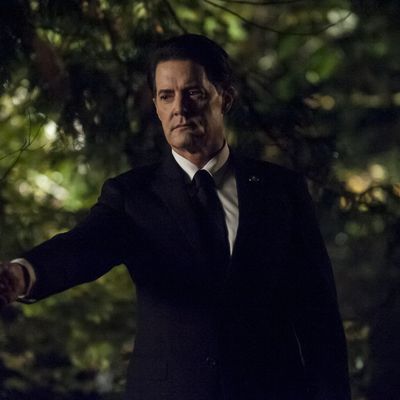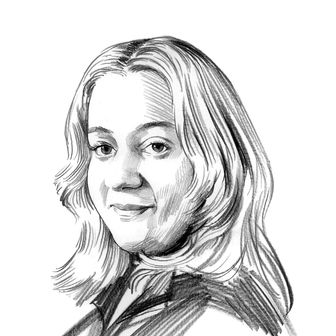
All summer long, fans of Twin Peaks: The Return have analyzed and dissected pretty much everything series creators David Lynch and Mark Frost put forth in each episode — and we mean everything. The numbers! The sounds! The names! But now that the season is officially over, what are we to speculate on? Even though we were granted a handful of satisfying answers in the two-part finale, there are still way more questions to unpack, especially after that chilling last scene between Agent Cooper and Laura Palmer. Let’s dive into five of the most popular theories about what it all meant.
Dale Cooper and Laura Palmer are stuck in an alternate dimension
Consider this a case of a hero trying to do the right thing. Even though he finally makes his way back to Twin Peaks and witnessed the death of his evil doppelgänger, that’s simply not good enough for our purehearted Agent Cooper — he wants, he needs, to save Laura Palmer. “I hope I see all of you again,” he tells his group of friends at the Twin Peaks Sheriff’s Department, knowing the difficulty of what’s to come. “Every one of you.” Although Cooper initially manages to steer Laura out of harm’s way in that Fire Walk With Me–era scene, thanks to some Phillip Jeffries–aided time travel, it all quickly goes downhill from there.
As this theory goes, the Judy entity — which Gordon Cole described as an “extreme negative force” — refused to allow Laura to escape her destiny. Laura slips away from Cooper’s hand, seemingly creating a world in which she was never murdered, but actions yield consequences. What if, because of Cooper’s attempted heroism, Laura Palmer never existed at all? When we next see her, she’s living under the identity of “Carrie Page” in Odessa, Texas, likely because Judy placed her in an alternative dimension to keep her out of the real world. Cooper tries to bring Laura back “home” to Twin Peaks, only to discover that her mother, Sarah Palmer, never lived there. In fact, the current and previous owners of the home, Mrs. Tremond and Mrs. Chalfont, are the names of mythological women we encountered in Twin Peaks’ original era. When “Carrie” comes to the scream-filled realization of who she really is, Judy shuts off the dream world and transports Cooper back to the Red Room, as implied in the closing credits sequence. He’ll now have to start his search all over again, forever and ever.
Sarah Palmer is possessed by Judy
The strongest evidence of this theory is the confrontation between Sarah and the bar harasser in “Part 14” — where she literally pulls off her face and then tears out the man’s throat — but a pair of scenes in the last two episodes also back it up. When Bad Cooper meets with Teapot Phillip Jeffries at the Dutchman, the numbers 7, 0, and 8 emerge from the Owl Cave symbol as Jeffries tells him, “This is where you’ll find Judy … there may be someone. Did you ask me this?” 708 is the house number of the Palmer residence in Twin Peaks. Then, in the immediate aftermath of Agent Cooper traveling back in time to prevent Laura Palmer’s murder, the scene cuts to Sarah Palmer in her home forcefully stabbing Laura’s framed high-school portrait, as if she wanted to erase her from memory. (A lot of unusual, grating sound bites occur before and after the stabbing, like the passage of time flickering on and off.) Judy ultimately gets her wish: Hello, Carrie Page and a new dimension.
Judy thrives on electricity
What if Judy doesn’t need a person as a host at all? With the motif of electricity recurring throughout The Return, Judy could’ve solely been operating out of overhead power lines throughout the country. Take a closer look at the scene where Agent Cooper and Diane drive 430 miles before they seemingly cross into a new dimension with their car: A handful of power lines encompass a stretch of otherwise barren land, and the most prominent structure echoes both the Owl Cave symbol and the ominous symbol Mr. C had on his playing card. (Here’s a nifty photo comparison created by a Reddit user.) The crackling of electricity Cooper hears in the area also suggests something is afoot — “This is the place, all right” — and when he and Diane drive through the electrical area, they’re immediately transported into a new environment. As Deputy Hawk put it best earlier in the season about the symbol: “You don’t ever want to know what that is.” When you cross Judy’s threshold, you’ll find yourself in an entirely new dimension and you’ll never be able to get back home.
It was all Laura Palmer’s dream
Right before “Carrie” lets out that iconic, blood-curdling scream to end season three, there’s a faint sound of someone saying “Lauraaaaa.” You know who it sounds like? Sarah Palmer … in the same cadence she used to tap on Laura’s door to see if she was awake in the very first Twin Peaks episode. But Laura isn’t dead and wrapped in plastic by the side of the water anymore. She’s alive, so perhaps it was all a nightmarish dream she constructed in her imagination to bring us back full circle. “We are like the dreamer, who dreams, and then lives inside the dream,” Monica Bellucci told Gordon Cole earlier this season. “But who is the dreamer?” In this case, that dreamer would be Laura, who has always been the central focus of the series.
“Richard” is the actual dreamer
When Agent Cooper wakes up the morning after his tryst with Diane in a motel room, he discovers a letter by his side, addressed to a Richard from a Linda. “When you read this I’ll be gone. Please don’t try to find me, I don’t recognize you anymore,” the letter reads. “Whatever it was we had together was over.” Assuming the man we know as Cooper is, in fact, a man named Richard, he then proceeds to investigate Laura Palmer’s whereabouts in a style that can perhaps be best described as a hybrid of the Agent Cooper we know and love and Mr. C. (For starters, he attacks a bunch of cowboys at a diner named Judy’s, and, although he’s generally compassionate in the presence of Carrie Page, he still maintains a detached demeanor throughout their whole drive to Twin Peaks.) What if Richard is actually a modern-day FBI agent who’s lost his sanity, crafting up this story of Laura Palmer and Twin Peaks as we know it? Or, even worst, what if he’s an average man who spins these elaborate tales of being an FBI agent into reality to entertain his broken mind? Sure, it wouldn’t be the most fulfilling way to end Twin Peaks, but it’s definitely something to think about.





